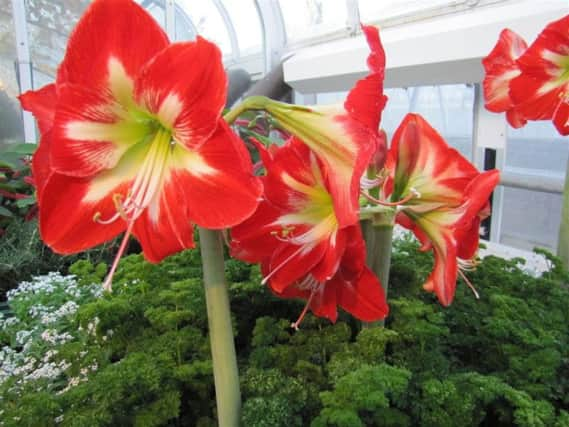BRIAN KIDD: Rescued from winter blues by flowering star knights


The correct botanical name for them is Hippeastrum – the Greek term hippeus means ‘a knight’, while astron means a star, so we have the star knight if you like!
Originated in South America and initially grown in Britain in the 17th century, they were exceptionally rare in those days and one bulb would be worth over £100. But nowadays, you can buy them in all garden centres.
Advertisement
Hide AdAdvertisement
Hide AdThe instructions on the packs are clear and there’s no reason to be concerned because the bulb has been stored at the correct temperature so that within a few weeks of planting, the flowers arrive and sometimes even more spikes are produced. The bigger the bulb, the more likely it is to have more stems of flower.
As soon as the plant comes into flower, begin watering it with a diluted plant food in water using a high potash food such as Maxicrop for tomatoes or any liquid tomato food. Keep the plant in bright light all the time.
As soon as the flowers fade, take off the seed heads but leave the flower stem intact and it will gradually wither, become yellow and light brown, after which it is cut off at the base.
The leaves will become very tall but the more light there is available, the shorter the leaves will be.
Advertisement
Hide AdAdvertisement
Hide AdKeep watering and feeding once a week all summer but stop in the middle of August. Place the pot on its side inside in hot sun so the leaves die back.
If they don’t then cut them off two inches above the neck of the bulb in October and take off all the old compost – but don’t break off too much root – and repot the bulb into John Innes Compost No.3 into the same size pot.
Place the bulb in a bright spot at home for the rest of the year, but do not water until you see the plump bud appearing in the neck of the bulb. Now start all over again with the feeding as already described.
The bulbs often have daughter bulbs alongside the mother bulb. Leave these in place until October when the bulb is re-potted, split off the daughter and place into the same compost.
Advertisement
Hide AdAdvertisement
Hide AdDaughter bulbs are watered all the time with diluted fertiliser, but are not usually dried off as per the parent until they become of flowering size – about the size of an egg, and about three years after being separated from the mother.
Seeds take up to five years to flower. Sow in June, prick out into a seed tray and leave them there for the first year.
Pot into single pots in April, water and feed with diluted fertiliser such as Phostrogen each week until the end of August. Re-pot in April each year into JI compost, using No.1 for smallest pots, No.2 for three-inch pots and No.3 for larger pots.
To be honest, it’s not really worthwhile and it would be much better to have removed the seed heads to prevent the seeds forming.
Advertisement
Hide AdAdvertisement
Hide AdIt is one of the reasons why they don’t flower every spring: producing seeds causes the bulb to have to cope with too much.
If you would like to grow real amaryllis outdoors, the bulbs are almost £4 each (Keydell) but if planted now and labelled, you will enjoy seeing the leaves emerge in spring. They then die down by the end of summer and you will be pleased to see the outdoor blooms in October – another time of year when we all need cheering up!
THIS WEEK’S TOP TIP
There are lots of coloured primroses and polyanthus in pots at garden centres. Smell the flowers and you should be able to choose some with perfume. They will grow beautifully on the windowsill in a nice light window. Remember what your mum always said, choose those with lots of unopened buds under the foliage. Good ol’ mum, she was always right.